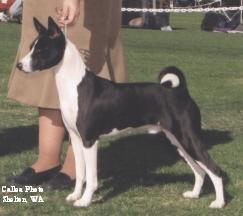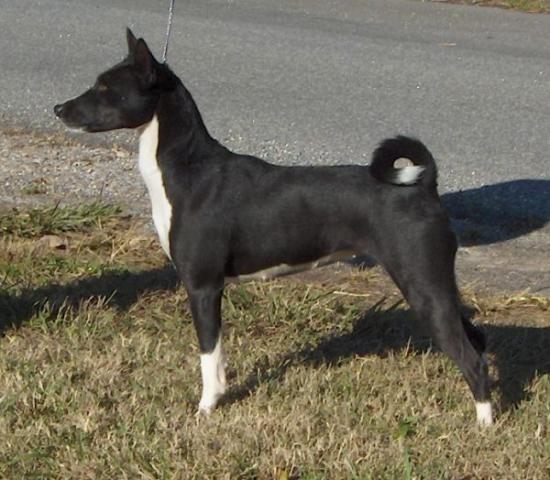Coat Color Inheritance in basenji
-
Kk YY - black
Kk Yy - tri factored black
Kk yy - tri factored blackkk YY - red
kk Yy - tri factored red
kk yy - tricolorWhere did you get the bold ones. I understand how to get the others but if you do it and add them together it makes no sense. …to me
OR do you have to do
1....2
3....41...2
3...4do you have to do 1 with 1, 1 with 2, 1 with 3, 1 with 4....then 2 with 2, 2 with 3, 3 with 4....then 3 with 3, 3 with 4....then 4 with 4. and then take all the alike genes and group them. then take all the unalike genes and
that is how you go the 2 extra genes?
(I used 1,2,3,4 just to make it easier to understand than using letters K, Y, etc.) -
from K locus we got:
Kk (and again Kk) - 1
kk (and again kk) - 2from A locus we got:
YY - a
Yy (and again Yy) - b
yy - c1 + a = 1a (Kk YY)
1 + b = 1b (Kk Yy)
1 + c = 1c (Kk yy)
2 + a = 2a (kk YY)
2 + b = 2b (kk Yy)
2 + c = 2c (kk yy)Oh ook i think i get it now, thx for the help in clearifying it. so would "A" always be YY, "b" always be Yy and "C" always be yy? or is that just for this example?
-
oh. so how do you know what to use then. :(
-
It depends on the alleles of the dog. The litter that I co-bred and have been posting puppy pictures of the parents are KkYy and KkYY. If you do the two punnet square way instead of the 16 punnet square way you would get.
At the K locus
….......K........k
K........KK.......Kk
k........Kk.......kkAt the A locus
.............Y.............y
Y..........YY...........Yy
Y..........YY...........YySo we get
from K locus we got:
KK - 1
Kk (we get this twice) - 2
kk - 3from A locus we got:
YY (we get this twice) - a
Yy (we get this twice) - b1 + a = 1a (KK YY)
1 + b = 1b (KK Yy)
2 + a = 2a (Kk YY)
2 + b = 2b (Kk Yy)
3 + a = 3a (kk YY)
3 + b = 3b (kk Yy) -
hmmm. I guess i dont really get this part. How do you do a 16 punnet square? Maybe that will be easier for me. (maybe not lol)
ill try to examine them some more and see if i cant get it down.
-
Ok thank you :) id like to see that
-
It depends on the alleles of the dog. The litter that I co-bred and have been posting puppy pictures of the parents are KkYy and KkYY.
What is KkYy? is this a Black basenji with a tri gene? and KkYY. is this a red Basenji with a black gene?
these are, ironically, the only two that i didnt understand what they would be as dogs.
-
Cole - has a black and white dam and a tri dad. Based on his mom's litters we believe she is KkYY which makes him KkYy. He has to carry tri since his dad is tri.
TC - has a black and white sire and red and white dam. Based on pedigree and breedings, we believe she is KkYY.


-
O ok this makes sense. Is there a way you could help me determine what my girl is? Ill link the colors of the parents and maybe you can help me determine what she is.
http://prairielandbasenjis.webs.com/colorinheritance.htm
I put the link on my website. With a couple questions for you on there. Once i figure everthing out i wont be having it on there anymore. If you could try to determine what she is i would greatly appreciate it! But also if you could remember how you did it and explain it to me so i can understand. Thank you!
-
Cole - has a black and white dam and a tri dad. Based on his mom's litters we believe she is KkYY which makes him KkYy. He has to carry tri since his dad is tri.
TC - has a black and white sire and red and white dam. Based on pedigree and breedings, we believe she is KkYY.
What did this breeding result in with a litter, Color wise? and if cole had been a kkYy (red male) what would/could they have produced then?
-
O ok this makes sense. Is there a way you could help me determine what my girl is? Ill link the colors of the parents and maybe you can help me determine what she is.
http://prairielandbasenjis.webs.com/colorinheritance.htm
I put the link on my website. With a couple questions for you on there. Once i figure everthing out i wont be having it on there anymore. If you could try to determine what she is i would greatly appreciate it! But also if you could remember how you did it and explain it to me so i can understand. Thank you!
Well since she is red she is definately kk and has at least one Y. There is about a 50% chance that she is a tri carrier. So she is either kkYy or kkYY
-
What did this breeding result in with a litter, Color wise? and if cole had been a kkYy (red male) what would/could they have produced then?
This resulted in 3 black and whites and 1 red and white. Statistically bred a tri factored red she should produce 50% reds and 50% blacks. Her first litter was sired by a tri factored red and she had 2 reds and 3 blacks.
